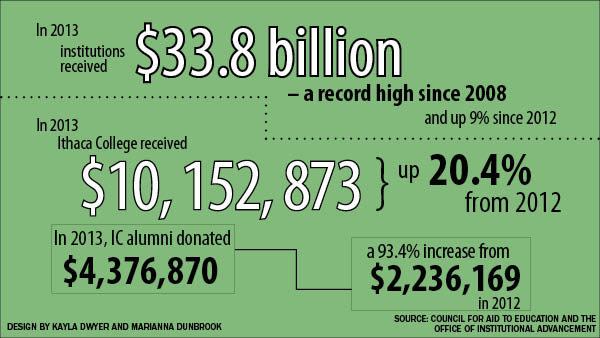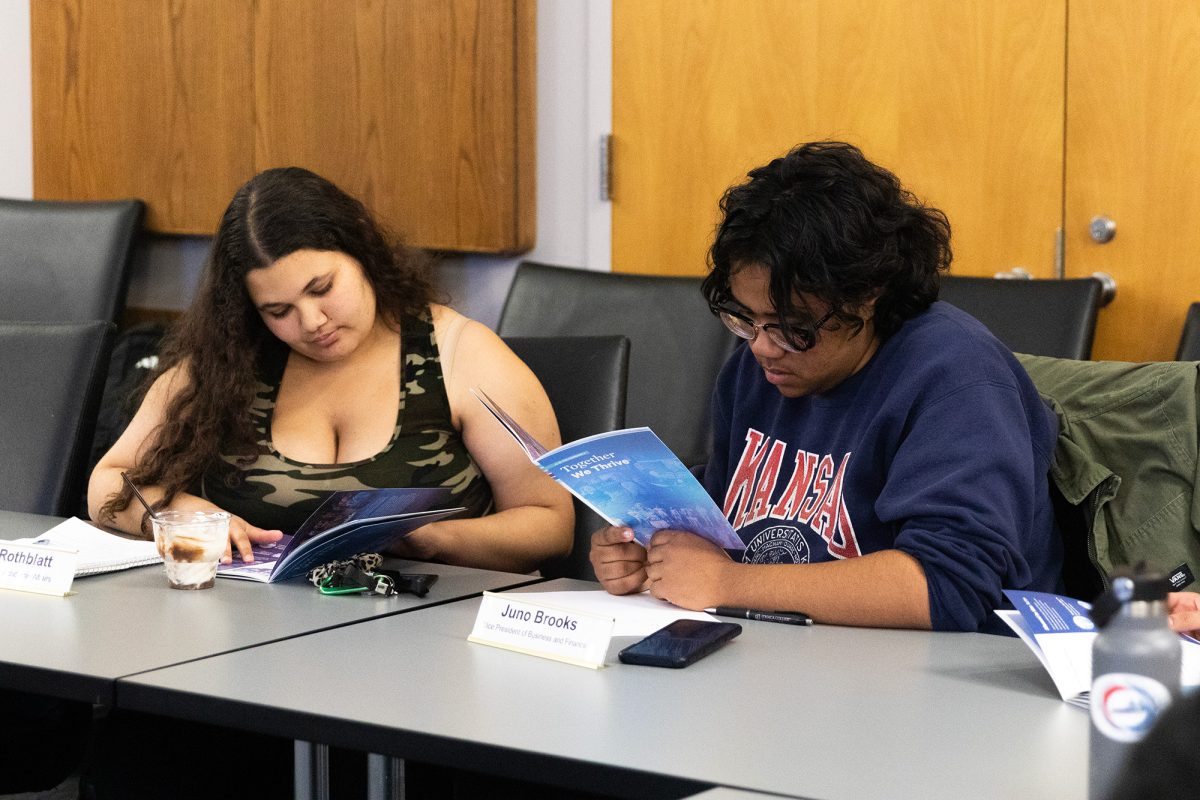Total charitable donations to Ithaca College have outpaced the national average for the year 2013, which saw a 9 percent growth in total giving to institutions across the country, according to a report by The Chronicle of Higher Education.
The college received an increase of 20.4 percent in total giving — including alumni, foundations and corporations — which is more than double the national average, Ann Kaplan, director of the Voluntary Support of Education survey, said.
The survey, administered by the Council for Aid to Education, evaluated the total and alumni gifts donated to 1,048 participating institutions, including the college, and released the results Feb. 12. Kaplan said the college saw a 93.4 percent increase in exclusively alumni giving for the calendar year 2013.
Stephen Savage, associate vice president in the Office of Institutional Advancement, said the college’s total alumni giving increased from $2,263,169 in 2012 to $4,376,870 in 2013, which accounts for the high percentage. Kaplan said the near doubling could be explained by two large personal gifts, $1.72 million and $1.13 million, that were donated anonymously in 2013. The latter gift was designated to the investment curriculum in the School of Business, Rob de la Fuente, director of the Ithaca College Annual Fund, said.
De la Fuente said the annual fund staff had been working closely with these donors to determine how their contributions would align with their interests.
Savage said the college has become more sophisticated with its soliciting techniques. In terms of overall gifts, the college received $10.1 million in the fiscal year June 2012 to May 2013. Of this amount, he said, $1.16 million was donated to the annual fund, which is a record.
De la Fuente said alumni made up more than half of the donor pool for the $1.16 million, followed by parents. He said 38.8 percent of the 2013 Senior Class contributed to the fund, a record for any senior class. The Alumni Association Board of Directors matched these gifts by donating $65 per gift to the annual fund.
The 2014 Senior Class Gift Campaign has set its goal for participation rate at 40 percent of the senior class, which is 640 seniors, co-chair senior Zachary Woelfel said. He said the monetary goal is to raise $12,150 by May 1 to go toward the annual fund or various designations by school or program, depending on the seniors’ choice.
“What’s nice is seniors have the option of giving where they really enjoyed their Ithaca College experience,” he said.
Savage said the Ithaca College Annual Fund contains money raised to benefit the entire college by helping offset the gap between tuition and awarded financial aid, supporting faculty and services such as Career Services and the Academic Advising Center and enhancing the campus experience.
“We’ve really been emphasizing the importance of a solid annual fund,” he said. “By 2020, our goal is to double that so that we’re raising $2.4 million annually for the annual fund.”
This is all part of the college’s comprehensive campaign to develop stronger faculty, student financial aid and capital projects such as the Integrative Core Curriculum and First-Year Residential Experience, Savage said. This campaign is still in its planning stages within the IC 20/20 strategic plan, to which he said he attributes much of the gains in donations.
“[IC 20/20] provides donors with a tangible framework for philanthropic opportunities so they can see where making a major investment in the college is going to make an impact,” he said.
Michael Kaplan, chair of the Annual Fund, graduated from the college in 1985 and currently serves as the alumni trustee to the Ithaca College Board of Trustees. He said the annual fund supports the college’s education with unrestricted giving that can be attributed to a variety of sources.
“There has been an emphasis to try to encourage donors to contribute to the annual fund to help the college where it needs the most,” he said.
Woelfel said he donates because he wants to make sure future students can have the same great experience he has had at the college.
“We want to make sure that Ithaca College stays the special place it is, and by supporting the annual fund, no matter how much you’re able to give, it’s making sure that that is still the reality,” he said.
De la Fuente said the annual fund has existed for more than 50 years. From May 2012 to June 2013, Savage said, there was a 14.9 percent increase in donors to the college’s annual fund. This is in contrast to the national rate of alumni participation, which dropped by half a percentage point according to The Chronicle.
The phenomenon of colleges receiving more gift money while giving participation has decreased is explained by the formula of alumni participation, which Ann Kaplan said is calculated by dividing the number of active donors by the number of alumni addresses on record. She said advances in technology have made it easier to access a larger number of addresses.
“The speed and accuracy with which you can identify an address is just staggering, and philanthropy hasn’t changed that much, so the denominator keeps going up,” she said.
She said while there are fewer donors, these few contribute higher average gift amounts, as is the case with the college.
“Our alumni participation rate as of this past year was 8.8 percent,” Savage said. “We really expect to see that increase.”
Cornell University saw a 43.5 percent increase in total giving — from $330.9 million in 2012 to $475 million in 2013 — and a 42.9 percent increase in alumni giving — from $175.6 million in 2012 to $250.9 million in 2013 — according to VSE data.
Richard Banks, associate vice president of alumni affairs at Cornell, said these increases result from a long period of significant capital campaign fundraising that has collected $4.6 billion in the past eight years. This money has gone to such projects as Cornell’s technology campus to be built on Roosevelt Island in New York City, he said. He said Cornell’s annual fund base has raised about $10 million per year in the last 10 years and raised triple that amount — more than $33 million — last year.
“We ask people to support the things that are important to them,” he said. “The dollars are frankly most effectively used when they’re given that way.”
Michael Kaplan said the college continues to expand its efforts to encourage the participation of upwards of 55,000 alumni.
“The goal is to try and get more people to participate on a regular basis and give what they can give, and try and make Ithaca one of their top choices,” he said.








